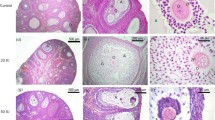Abstract
The effect of various concentrations of cadmium (Cd) in levels ranging from 0.75 to 12 μg/ml medium, on the secretion of human chorionic gonadotropin (hCG) in first-trimester placental expiants, after 6 or 24 h incubation, employing both static and dynamic systems was examined. Later the unbound Cd was washed for 45 min with fresh medium devoid of Cd, followed by superfusion with the latter medium for 75 min, during which time samples were collected for hCG assay. For the superfusion experiments the parameters used for evaluating the hCG secretion pattern were: mean peak amplitude (MPA), pulse frequency (PF) and the area under the hCG secretion curve (AUC). The results indicate that in the dynamic system the hCG secretion increased significantly, and this increase was dose dependent. There was also a dose-related increase in mean total hCG secreted by the explants exposed to Cd. Maximal hCG secretion was observed after 24 h exposure of explants to 6 μg of the metal/ml. Both the MPA and AUC parameters showed a statistically significant increase for this dose level. At 12 μg/ml, the pulsatile secretion of hCG decreased, the value for the mean hCG secretion being comparable to that observed for 0.75 μg/ml. After 6 h incubation, however, there were no significant changes from the control, as judged by all of the above parameters. The levels of hCG secreted by the explants into the media in the static system were not significantly different from their respective controls, for both incubation periods and Cd levels. These results indicate that Cd may affect the normal placental function, as reflected in its hCG secretion pattern.
Similar content being viewed by others
References
Barnea ER, Avigdor S (1990) Coordinated induction of estrogen hydroxylase and catechol-O-methyl transferase by xenobiotics in first trimester human placental explants. J Steroid Biochem 35: 327–331
Barnea ER, Kaplan M (1989) Spontaneous gonadotropin-releasing hormone induced, and progesterone inhibited pulsatile secretion of human chorionic gonadotropin in the first trimester placenta in vitro. J Clin Endocrinol Metab 69: 215–217
Barnea ER, Feldman D, Kaplan M, Morrish DW (1990) The dual effect of epidermal growth factor upon human chorionic gonadotropin secretion by the first trimester placenta in vitro. J Clin Endocrinol Metab 71: 923–928
Barnea ER, Ashkenazi R, Sarne I (1991 a) The effect of dynorphin on placental pulsatile hCG secretion in superfusion. J Clin Endocrinol Metab (in press)
Barnea ER, Kaplan M, Feldman D (1991 b) The effect of progesterone on hCG secretion and cellular differentiation in the first-trimester placenta. Hum Reprod (in press)
Boadi WY, Yannai S, Urbach J, Brandes JM, Summer KH (1991) Transfer and accumulation of cadmium, and the level of metallothionein in perfused human placentae. Arch Toxicol 65: 318–324
Chiquoine AD (1965) Effect of cadmium chloride on the pregnant albino mouse. J Reprod Fertil 7: 263–264
di Sant'Agnese PA, Jensen K, Levin AA, Miller RK (1983) Placental toxicity of cadmium: an ultrastructural study. Placenta 4: 149–163
Juchau MR (1982) The role of the placenta in developmental toxicity. In: Snell K (ed) Developmental toxicology. Praeger, NY, pp 188–209
Kaplan SL, Grumbach MM (1978) Pituitary and placental gonadotropins and sex steroids in human and subhuman primate fetus. J Clin Endocrinol Metab 7: 487–511
Levin AA, Plautz JR, di Sant'Agnese PA, Miller RK (1981) Cadmium: placental mechanisms of fetal toxicity. Placenta (Suppl 3): 303–318
Levin AA, Miller RK, di Sant'Agnese PA (1983) Heavy metals alterations of placental function: a mechanism for the induction of fetal toxicity of cadmium. In: Clarkson T, Nordberg G, Sager PR (eds) Reproductive and developmental toxicity of metals. Plenum Press, NY, pp 633–654
Lowry OH, Rosebrough NJ, Farr AL, Randall RJ (1951) Protein measurements with the pholin phenol reagent. J Biol Chem 193: 265–269
Miller RK, Ng WW, Levin AA (1983) The placenta: relevance to toxicology. In: Clarkson T, Nordberg G, Sager PR (eds), Reproductive and developmental toxicity of metals. Plenum Press, NY, pp 569–605
Morrish DW, Marusyk H, Siy O (1987) Demonstration of specific secretory granules for human chorionic gonadotropin in placenta. J Histochem Cytochem 35: 93–101
Owens OM, Ryan KJ, Tulchinsky D (1981) Episodic secretion of human chorionic gonadotropin in early pregnancy. J Clin Endocrinol Metab 53: 1307–1309
Parizek J (1964) Vascular changes at sites of estrogen biosynthesis produced by parental injection of cadmium salts: the destruction of placenta by cadmium salts. J Reprod Fertil 7: 263–264
Roth RA (1981) Effects of pneumotoxicants on lactate dehydrogenase activity in airways of rats. Toxicol Appl Pharmacol 57: 59–78
Simpson ER, MacDonald PC (1981) Endocrine physiology of the placenta. Annu Rev Physiol 43: 163–168
Zimmerman HJ, Weinstein HG (1956) Lactate dehydrogenase activity in human serum. J Lab Clin Med 48: 607–616
Author information
Authors and Affiliations
Rights and permissions
About this article
Cite this article
Boadi, W.Y., Shurtz-Swirski, R., Barnea, E.R. et al. Secretion of human chorionic gonadotropin in superfused young placental tissue exposed to cadmium. Arch Toxicol 66, 95–99 (1992). https://doi.org/10.1007/BF02342501
Received:
Accepted:
Issue Date:
DOI: https://doi.org/10.1007/BF02342501




